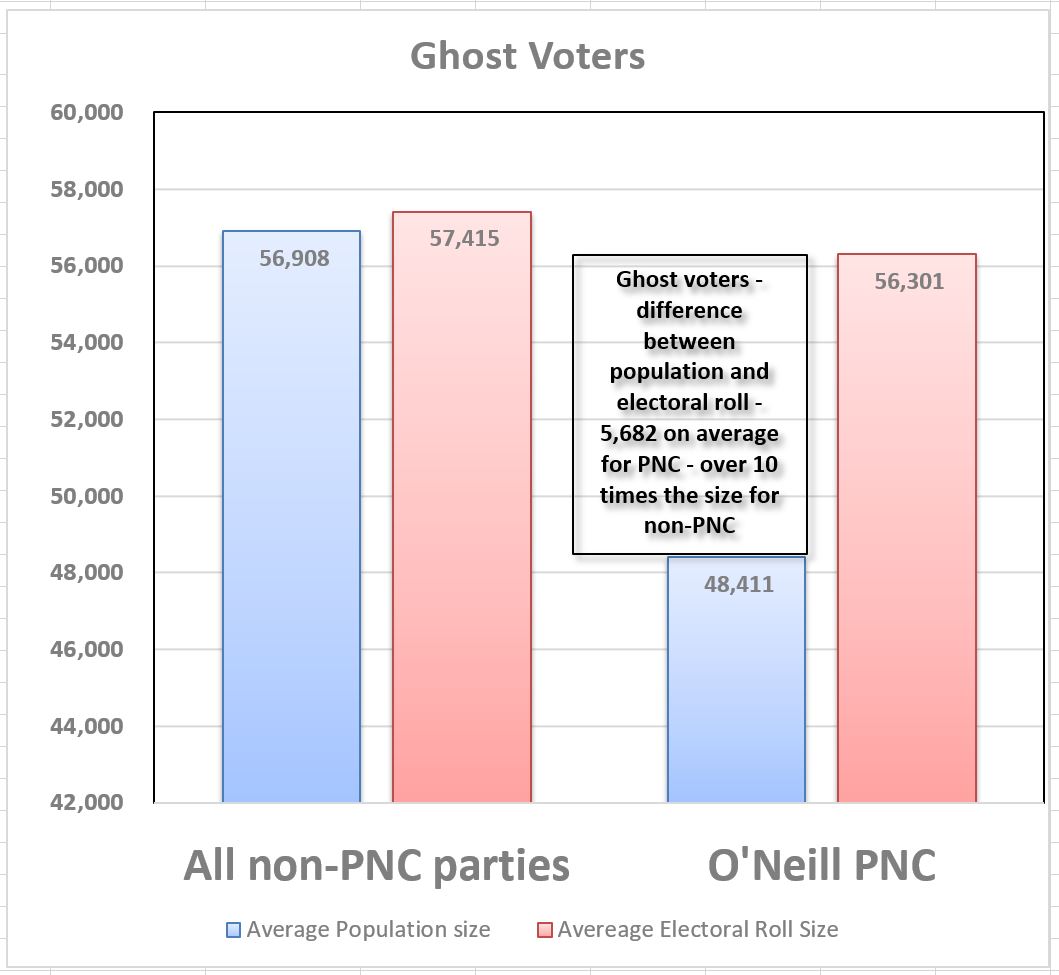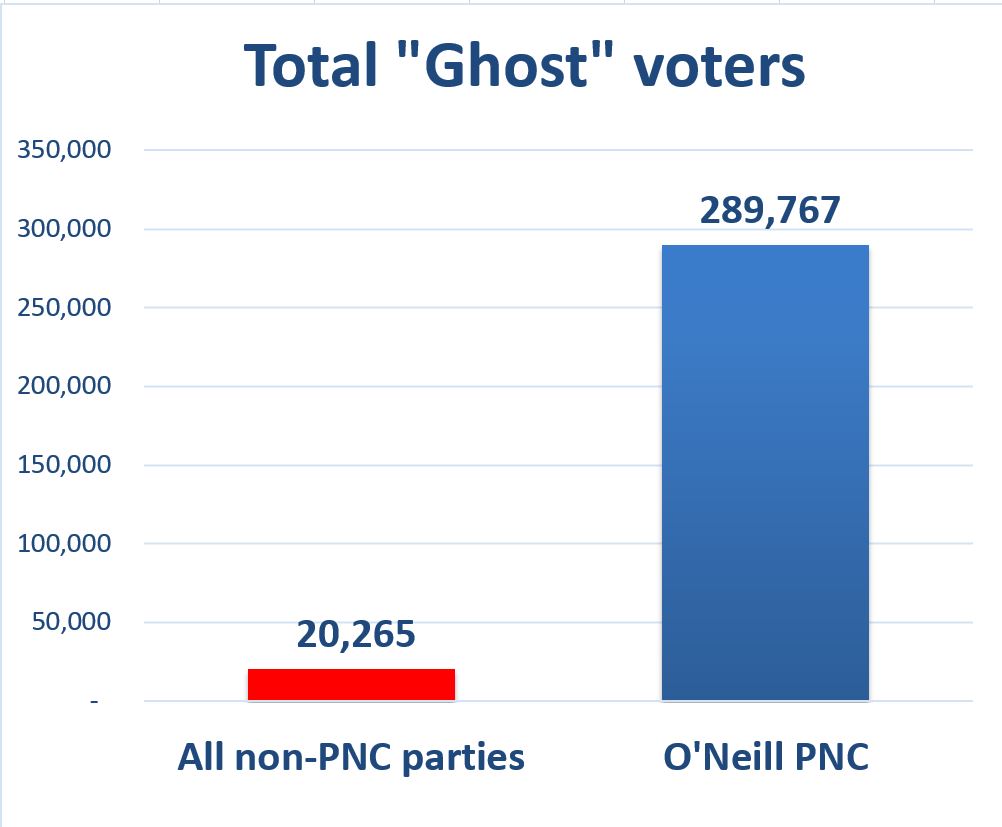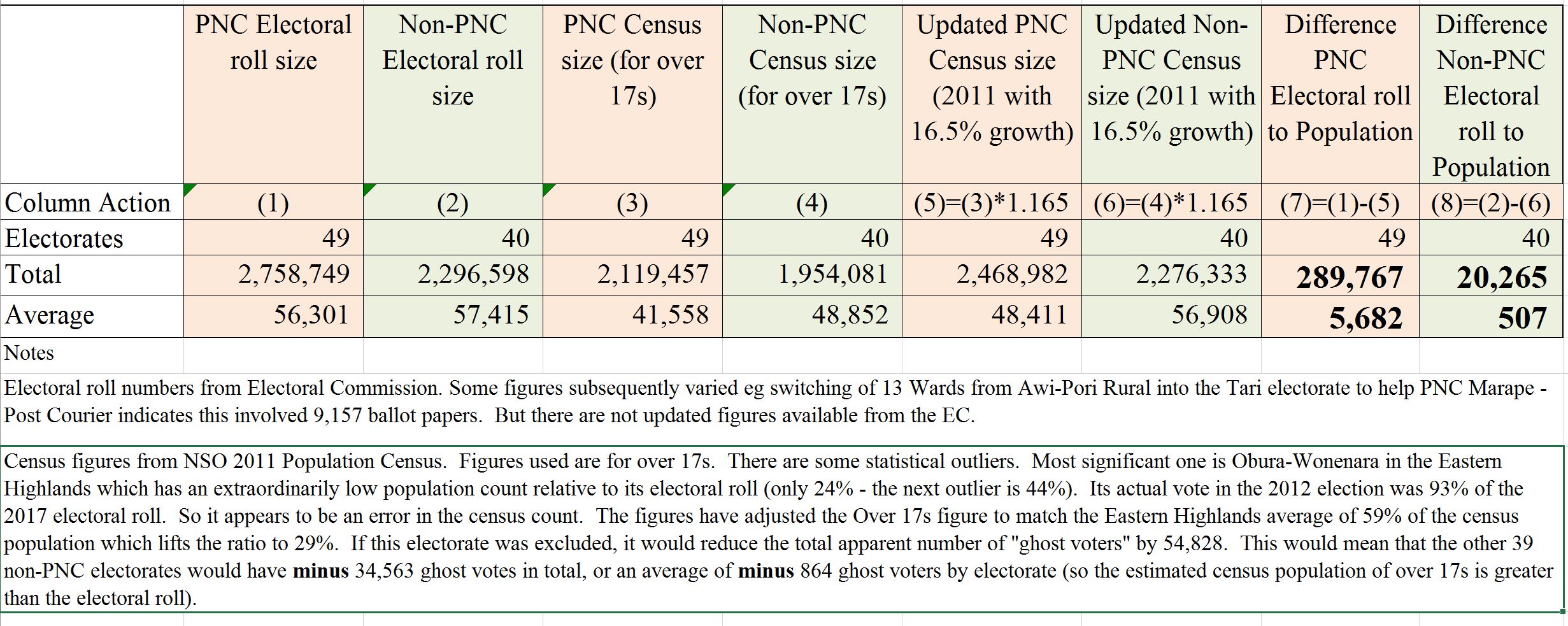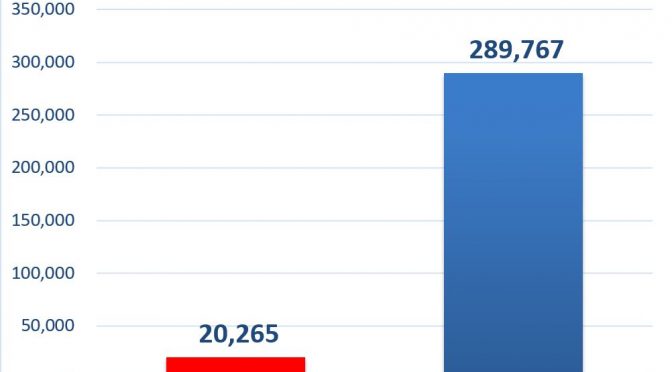Summary
Statistical indicators suggest the O’Neill government has used its power of incumbency to ‘cook the books’ in its favour. Comparing the 2017 electoral roll with population estimates by electorate based on the 2011 census, the Electoral Commission has created nearly 300,000 “ghost voters” in PNC controlled electorates. This is 5,682 “ghost voters” for every PNC sitting member. This is over 10 times the number of “ghost voters” for non-PNC sitting members. PNC members are also being declared elected based on “mathematical impossibilities”.
PNG’s vibrant democracy, including its extraordinary diversity and combination of individual choice and clan loyalties, may still be able to overcome such electoral bias in favour of O’Neill. This may depend on the Biblical and moral choices about to be made by new Independent members. May they choose wisely and morally, not just chasing the money politics of the PNC and its likely manipulation of the election, when they decide on PNG’s new government.
PNC’s army of “Ghost voters”
One extraordinary indicator of electoral bias is that O’Neill PNC supported electorates had, on average, an “extra” 5,682 people on the electoral roll relative to their population. The number of these “Ghost voters” is over ten times larger than the average of 507 for non-PNC electorates (details, including methodology, below).

Overall, there were nearly 300,000 more people on the electoral roll in PNC electorates than the latest population census would suggest. This is much greater than the extra 20,000 in non-PNC electorates.

It seems the cleansing of the 2017 electoral roll, assisted by Australia, was able to find nearly all the “ghost” electors in non-government seats, but failed abysmally in seats held by the government.
This is also a very sad comment on the quality of Electoral Commissioner’s management of the election. Combined with his failure to maintain the confidence of the independent Electoral Advisory Committee, he should resign and give power to a more independent body.
This type of electoral bias has provided nearly 300,000 extra votes available to government electorates.
But what does this mean in practical terms?
At the margin, this type of electoral bias made it more likely that your name would be on the roll if you turned up in an electorate controlled by the government. Many PNG citizens were disenfranchised by not having their name on the roll. For non-PNC electorates, if we exclude the statistical outlier of the electorate of Obura-Wonenara (which had a very , very unlikely figure of the census being only one-quarter of the electoral roll – nearly double the outlier of any other electorate), all other non-PNC electorates had on average 864 less names on the electoral roll than suggested by the latest census.
And the extensively reported “double voting” is easier to do when there are more names on the roll. And easier to sneak in a few extra pre-filled ballot boxes with your preferred candidate.
But the key issue here is how these “extra votes” are actually distributed at the sub-electorate level – so by LLG, Ward and even by polling station. The story of the Simbu election scrutineers (see here ) indicates the type of manipulations that are easier to do in electorates where the PNC members have many more “ghost voters”. As argued here, the devil is generally in the detail (apart from apparently crude stuff-ups such as the Marape vote – see below).
We know that due to clan loyalty, and views of leadership, some seats will comfortably go to particular people and parties – O’Neill, Basil etc. Marape’s re-election was expected, so it is hard to figure out why there would be manipulation (unless it was targeted as an early count, early declared victory to give a head-start to the vital government coalition formation process).
In the 89 open electorates (so not the 22 electorates based on electing a Governor for the Province who then sits in the 111 member Parliament), the average first preference vote was 8,500 – only 20% of all votes cast. If you had the most first preference votes, you then generally won the election– three-quarters of all elected members won their first preference count (see here).
So by adding even an extra thousand or two thousand possible votes in areas where candidates had particularly strong support, you could gain an extra few percent which can be vital for overall success. An average of 5,682 “ghost voters” provides enormous flexibility to manipulate the election.
Of course, there is an extraordinary amount of diversity and noise in the election. This type of game will not necessarily overcome other issues which possibly reduce popularity. They do not account for major election promises that are particularly beneficial to certain electorates (such as the Prime Minister’s K3.5 billion give away of a substantial share of its ownership of the PNG LNG project to landowners in Hela and other areas around the project – why wouldn’t you vote for the PNC with this massive handout even if it destroys your budget credibility and issues of equity across all of PNG?). There are many things that cannot be tested by some form of mathematical analysis to determine systematic bias – the courts can go into much more detail, such as whether voters are allowed to vote on Sundays and forms of intimidation in certain areas.
There are even more rigorous statistical tools available to inform an understanding of the electoral bias already very evident in this election. This would require more detailed information, as there is even more devil in the detail. It is a shame that the Electoral Commission is hiding more detailed information that would inform good public policy. It is understandable that the Electoral Advisory Committee resigned as it wasn’t getting this type of detailed information. However, possibly there is enough public information to inform their advice that there is a systemic bias towards the O’Neill PNC, and that some electorates have “mathematically impossible” outcomes.
Mathematical Impossibilities
Some “mathematical impossibility” bias indicators are crude but damning.
- For example, there has been no explanation provided for how the first “elected” member – the Hon. James Marape Minister for Finance – won in an electorate where there were between 7,000 and 20,000 more votes cast than there were names on the electoral roll, or shown in the latest population census.
- The “gerrymander” to shift 13 Wards this electorate accounts for possibly 9 to 12 thousand of the difference, but there still remains a huge gap of over 7,000 extra votes.
- This is the type of bias it would have been good for the Electoral Advisory Committee to examine, and if there remained major issues of “mathematical impossibility”, recommended that the election in that electorate should be re-run.
- As a general rule, unless some clear explanation can be provided, an election should be re-run if the number of votes cast exceed the number of people on the electoral roll or based on the latest census.
Next Steps
As the election count continues, a key third stage of the four stage election process (see EAC comments) there is still a great need for integrity from officials, scrutineers and police. There are still key decisions ahead for the Electoral Commissioner and even the Governor General. These decisions would be better informed if there was greater information sharing – this could help confirm the legitimacy of the election. Looking ahead, such analysis can also provide some benchmarks for hopefully making the 2022 election a much better and fairer election for whatever government emerges from this election.
There is also a key stage for government coalition formation. As expected, no party will win an absolute majority. There is a clear coalition of parties that are anti-O’Neill, including former coalition partner National Alliance headed by the former Treasurer (who was sacked in part for exposing other budgetary games played by the O’Neill government on the debt to GDP ratio and economic growth – the type of games indicating a willingness for the O’Neill government to play games with the electoral numbers).
These independent members will have a key role in shaping PNG’s future. Hopefully, they will reflect on the legitimacy of many PNC members who have been given an unfair head-start. Early choices by the “Independent” member for Koroba/ Lake Kopiago, Hon. Petrus Nane Thomas to immediately join PNC without time for considering alternatives is a disappointing start. May other Independent candidates be guided by the Bible and their moral vision to decide whether such deliberate bias should be rewarded with the right to rule.
Detail
The analysis for this blog is based on the distributed version of the 2017 electoral roll, the 2011 Population Census (updated by 16.5% for population increases since then – 5 years at a compounding annual growth rate of 3.1%), the ANU Electoral Database and information on who were actually PNC endorsed sitting members of parliament (this was based on the PNG Parliament website, except for 4 members whose party endorsement differed from the Parliamentary website eg Potape who was PNC in the parliament but not endorsed as the PNC candidate).
The excel tables providing all this information at the electorate level is available by emailing admin@pngeconomics.org. A summary of the totals and averages are set out in the following table –

This analysis has taken some time to put together. Over coming days, I will apply more detailed statistical tests to examine patters of electoral bias based on publicly available information. This analysis would be greatly assisted by more detailed information – the type of information that should be publicly available such as the number of actual ballot papers distributed by polling station. This is the type of information that was not even provided to the PNG Constitutional Electoral Advisory Committee. Unfortunately, I suspect that public policy analysis on the true level of possible fraud in this election will be buried by government authorities refusing to provide detailed information.

